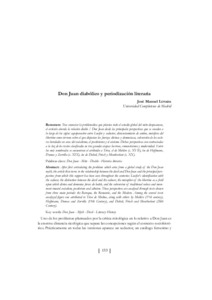Por favor, use este identificador para citar o enlazar este ítem:
https://repositorio.uca.edu.ar/handle/123456789/17138| Campo DC | Valor | Lengua/Idioma |
|---|---|---|
| dc.contributor.author | Losada, José Manuel | es |
| dc.date.accessioned | 2023-09-19T14:05:36Z | - |
| dc.date.available | 2023-09-19T14:05:36Z | - |
| dc.date.issued | 2007 | - |
| dc.identifier.citation | Losada, J. M. Don Juan diabólico y periodización literaria [en línea]. Letras. 2007, 55-56 . Disponible en: https://repositorio.uca.edu.ar/handle/123456789/17138 | es |
| dc.identifier.issn | 0326-3363 (impreso) | - |
| dc.identifier.issn | 2683-7897 (online) | - |
| dc.identifier.uri | https://repositorio.uca.edu.ar/handle/123456789/17138 | - |
| dc.description.abstract | Resumen: Tras enunciar la problemática que plantea todo el estudio global del mito donjuanesco, el artículo aborda la relación diablo / Don Juan desde las principales perspectivas que se suceden a lo largo de los siglos: equiparación entre Lucifer y seductor, distanciamiento de ambos, metáfora del libertino como terreno sobre el que disputan las fuerzas divinas y demoníacas, subversión de los valores heredados en aras del socialismo, el positivismo y el ateísmo. Dichas perspectivas son contrastadas a la luz de los textos clasificados en tres grandes etapas: barroco, romanticismo y modernidad. Entre los más nombrados se encuentran el atribuido a Tirso, el de Molière (s. XVII), los de Hoffmann, Dumas y Zorrilla (s. XIX), los de Delteil, Frisch y Montherlant (s. XX). | es |
| dc.description.abstract | Abstract: After first articulating the problems which arise from a global study of the Don Juan myth, the article then turns to the relationship between the devil and Don Juan and the principal perspectives from which this rapport has been seen throughout the centuries: Lucifer’s identification with the seducer, the distinction between the devil and the seducer, the metaphor of the libertine as a field upon which divine and demoniac forces do battle, and the subversion of traditional values and movement toward socialism, positivism and atheism. These perspectives are analysed through texts drawn from three main periods: the Baroque, the Romantic, and the Modern. Among the several texts analyzed figure one attributed to Tirso de Molina, along with others by Molière (17th century), Hoffmann, Dumas and Zorrilla (19th Century), and Delteil, Frisch and Montherlant (20th Century). | es |
| dc.format | application/pdf | es |
| dc.language.iso | spa | es |
| dc.publisher | Pontificia Universidad Católica Argentina. Facultad de Filosofía y Letras | es |
| dc.rights | Acceso abierto | * |
| dc.rights.uri | http://creativecommons.org/licenses/by-nc-sa/4.0/ | * |
| dc.source | 2007 nro. 55-56 | es |
| dc.subject | HISTORIA LITERARIA | es |
| dc.subject | DON JUAN | es |
| dc.subject | MITO | es |
| dc.subject | DIABLO | es |
| dc.title | Don Juan diabólico y periodización literaria | es |
| dc.type | Artículo | es |
| uca.disciplina | LITERATURA | es |
| uca.issnrd | 1 | es |
| uca.affiliation | Fil: Losada, José Manuel. Universidad Complutense de Madrid; España | es |
| uca.version | publishedVersion | es |
| item.fulltext | With Fulltext | - |
| item.languageiso639-1 | es | - |
| item.grantfulltext | open | - |
| Aparece en las colecciones: | LETRAS - 2007 nro. 55-56 | |
Ficheros en este ítem:
| Fichero | Descripción | Tamaño | Formato | |
|---|---|---|---|---|
| don-juan-diabolico.pdf | 96,8 kB | Adobe PDF |  Visualizar/Abrir |
Visualizaciones de página(s)
24
comprobado en 27-abr-2024
Descarga(s)
9
comprobado en 27-abr-2024
Google ScholarTM
Ver en Google Scholar
Este ítem está sujeto a una Licencia Creative Commons

